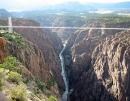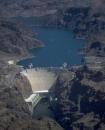Grand Canyon
How do you want to tour America's Grand Canyon?
Hiking? Mule ride? Airplane? Helicopter? Whitewater river raft? Train? Or motor vehicle, such as your own car or a tour bus, with stops at various lookout points where you can just gaze over this amazing 1.2 million acre natural wonder?
These are all possibilities. And, on Sunday, Feb. 26, members of the library's Talk Lab English Club took turns presenting the choices as part of learning about the Grand Canyon as well as practicing their English. Actually, they learned from each other, because the session's main activity entailed playing the role of Grand Canyon tour guides.
The session's 24 participants divided into teams to read information about the Grand Canyon and then prepared their tour-guide speeches. Photographs downloaded from the Internet helped everyone envision the canyon and many of its main features.
A trip to the bottom of the canyon and back - on foot or by mule - is a two-day journey. Rim-to-rim hikers usually take three days one-way to get from the North Rim to the South Rim. A trip through Grand Canyon by raft can take two weeks or longer, and experienced backpackers have spent weeks in the more remote areas of the canyon.
Here are some interesting facts about the Grand Canyon:
~ The colorful Grand Canyon, designated as a United States’ national park in 1919, is located in the southwestern state of Arizona, not too far from Las Vegas, Nevada. The park includes 1,218,375.54 acres or land (493,077 hectares), or 1,904 square miles (4,931 square kilometers).
~ About 5 million people from all over the world visit this park each year, and there are many fun things to do, including sightseeing, enjoying the breathtaking views, photography, camping, river rafting, and hiking any distance on the park’s 400 miles of trails.
~ The canyon is a gorge 277 miles long, up to 18 miles wide, with an average depth of 5,000 feet.
~ This gorge was carved 3 million to 6 million years ago by erosion forces of the Colorado River, which flows west through the canyon and averages about 300 feet in width and 100 feet in depth, and flows at an average speed of four miles per hour.
~ The water flow amounts to 800 million gallons per hour, or 3,028 liters.
~ The river continues to erode the canyon, making it even deeper.
~ The canyon is home to 88 species of mammals, 287 species of birds, 26 species of fish, 58 species of reptiles and amphibians, and about 1,500 species of plants.
~ The Grand Canyon is not the biggest canyon in the world. The two that are larger are Barranca de Cabre in northern Mexico and Hell’s Canyon in Idaho.
~ Fatalities: About 600 deaths have occurred in the Grand Canyon since the 1870s. Some of these deaths occurred as the result of overly zealous photographic endeavors, some were the result of airplane collisions within the canyon, and some visitors drowned in the Colorado River. Of the fatalities, 53 resulted from falls; 65 from environmental causes, including heat stroke, cardiac arrest, dehydration and hypothermia; 7 in flash floods; 79 drowned in the river; 242 perished in airplane and helicopter crashes; 25 in freak errors and accidents, including lightning strikes and rock falls; 48 committed suicide; and 23 were the victims of homicides.
In addition to “taking a trip” to the Grand Canyon, two Talk Lab members – Ivan and Yura – gave a special BBC-style interview presentation about the nearby Hoover Dam. Here are a few facts about that structure:
~ The Hoover Dam’s construction began in 1931, and it was completed five years later. It was built as a source of hydroelectric power generation, to provide water for agricultural purposes and to prevent floods.
~ The dam, named after U.S. President Herbert Hoover, once stood as the largest electric-power generating site in the world, as well as the largest structure made out of concrete. That is no longer the case.
~ The dam weighs more than 6.5 million tons, and incorporates more than million cubic yards of concrete – enough to construct a motorway connecting New York to San Francisco. There are 17 turbines, of which one is rated at 86,000 horsepower, one at 100,000 horsepower and the remaining 15 at 178,000 horsepower each.
~ The dam’s approximate annual power output is 4 billion kilowatt. When operating at full power, the 17 generators can supply all the electricity needed by a city of 750,000 people.
~ It is 726 feet tall, which is 171 feet higher than the Washington Monument in Washington, D.C. At its base, the dam is 660 feet thick.
~ Lake Mead, which was formed by the Hoover Dam, is the largest reservoir in the U.S.A. and contains enough water to flood the entire state of New York with 1 foot of water.






















Comments